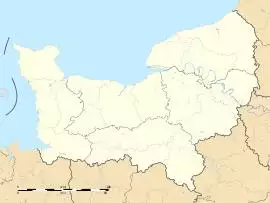Damblainville | |
|---|---|
 The church in Damblainville | |
Location of Damblainville  | |
| Coordinates: 48°54′59″N 0°06′41″W / 48.9164°N 0.1114°W | |
| Country | France |
| Region | Normandy |
| Department | Calvados |
| Arrondissement | Caen |
| Canton | Falaise |
| Intercommunality | Pays de Falaise |
| Government | |
| • Mayor (2014–2020) | Michel Caillouet |
| Area 1 | 6.35 km2 (2.45 sq mi) |
| Population (Jan. 2017)[1] | 241 |
| • Density | 38/km2 (98/sq mi) |
| Time zone | UTC+01:00 (CET) |
| • Summer (DST) | UTC+02:00 (CEST) |
| INSEE/Postal code | 14216 /14620 |
| Elevation | 54–157 m (177–515 ft) (avg. 80 m or 260 ft) |
| 1 French Land Register data, which excludes lakes, ponds, glaciers > 1 km2 (0.386 sq mi or 247 acres) and river estuaries. | |
Damblainville is a commune in the Calvados department and Normandy region of north-western France.
Its inhabitants are known as Damblainvillais.
Population
| Year | Pop. | ±% |
|---|---|---|
| 1946 | 231 | — |
| 1954 | 188 | −18.6% |
| 1962 | 165 | −12.2% |
| 1968 | 171 | +3.6% |
| 1975 | 230 | +34.5% |
| 1982 | 220 | −4.3% |
| 1990 | 193 | −12.3% |
| 1999 | 189 | −2.1% |
| 2007 | 211 | +11.6% |
| 2014 | 230 | +9.0% |
See also
References
- ^ "Populations légales 2017". INSEE. Retrieved 6 January 2020.

